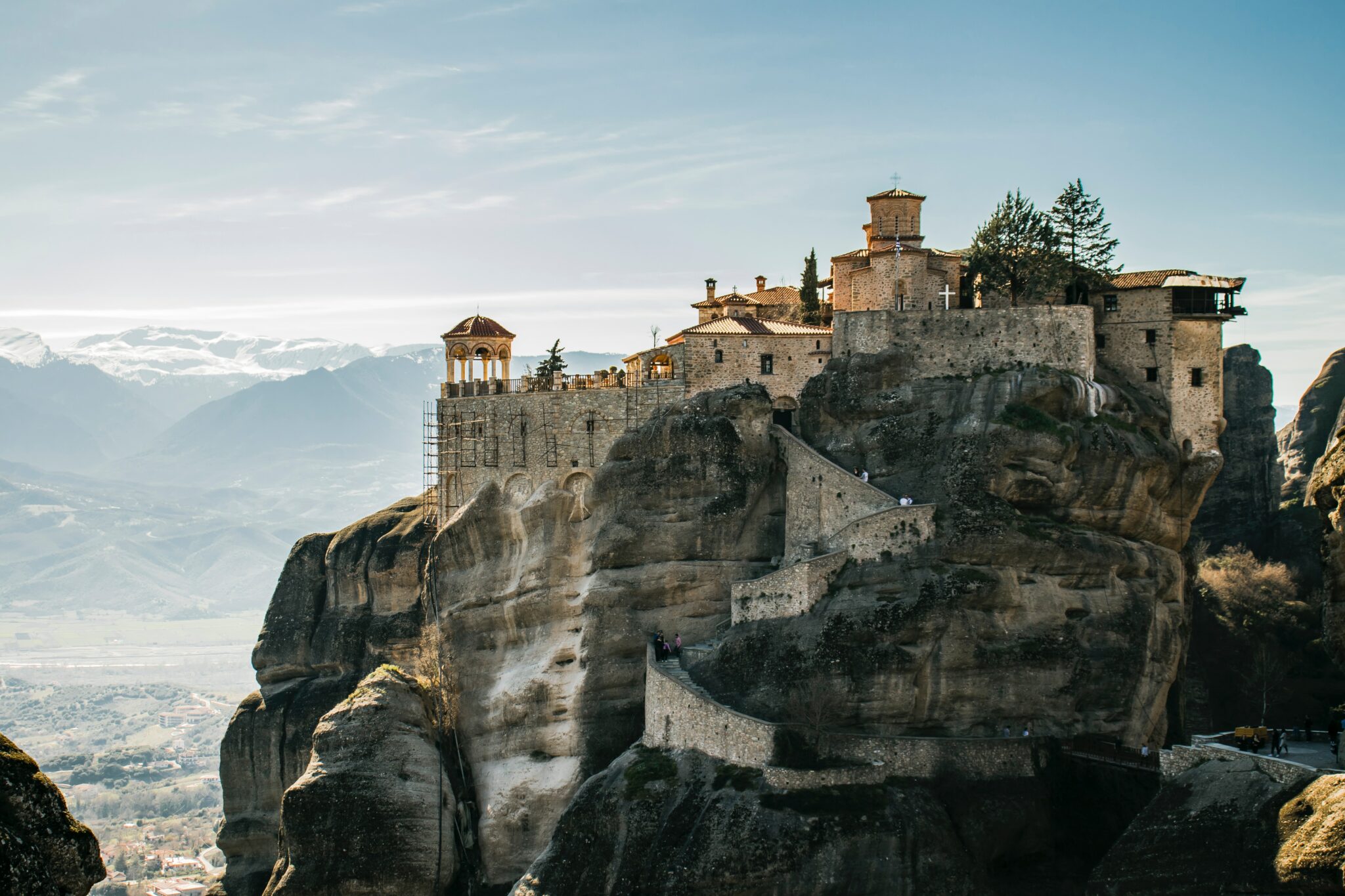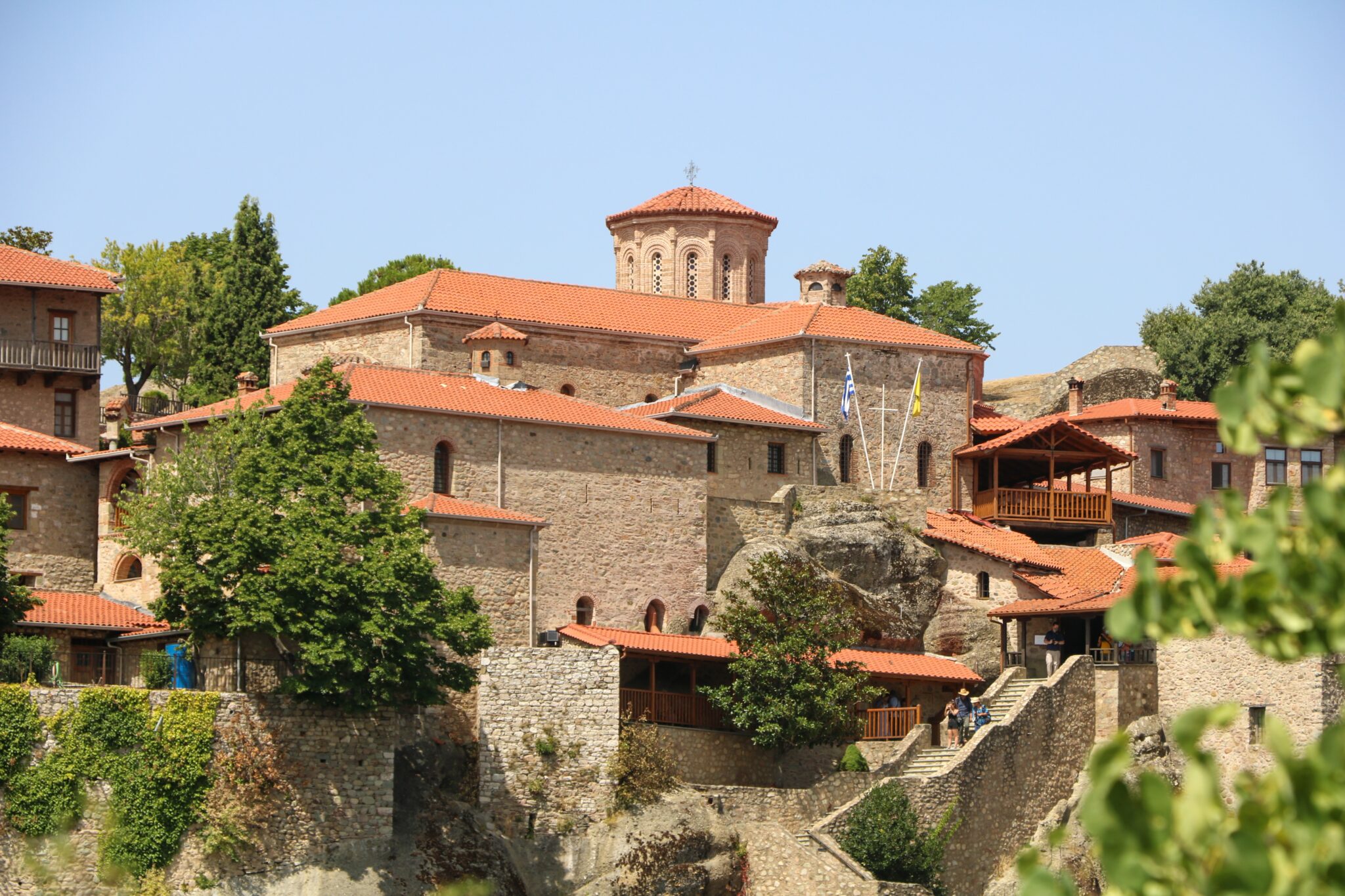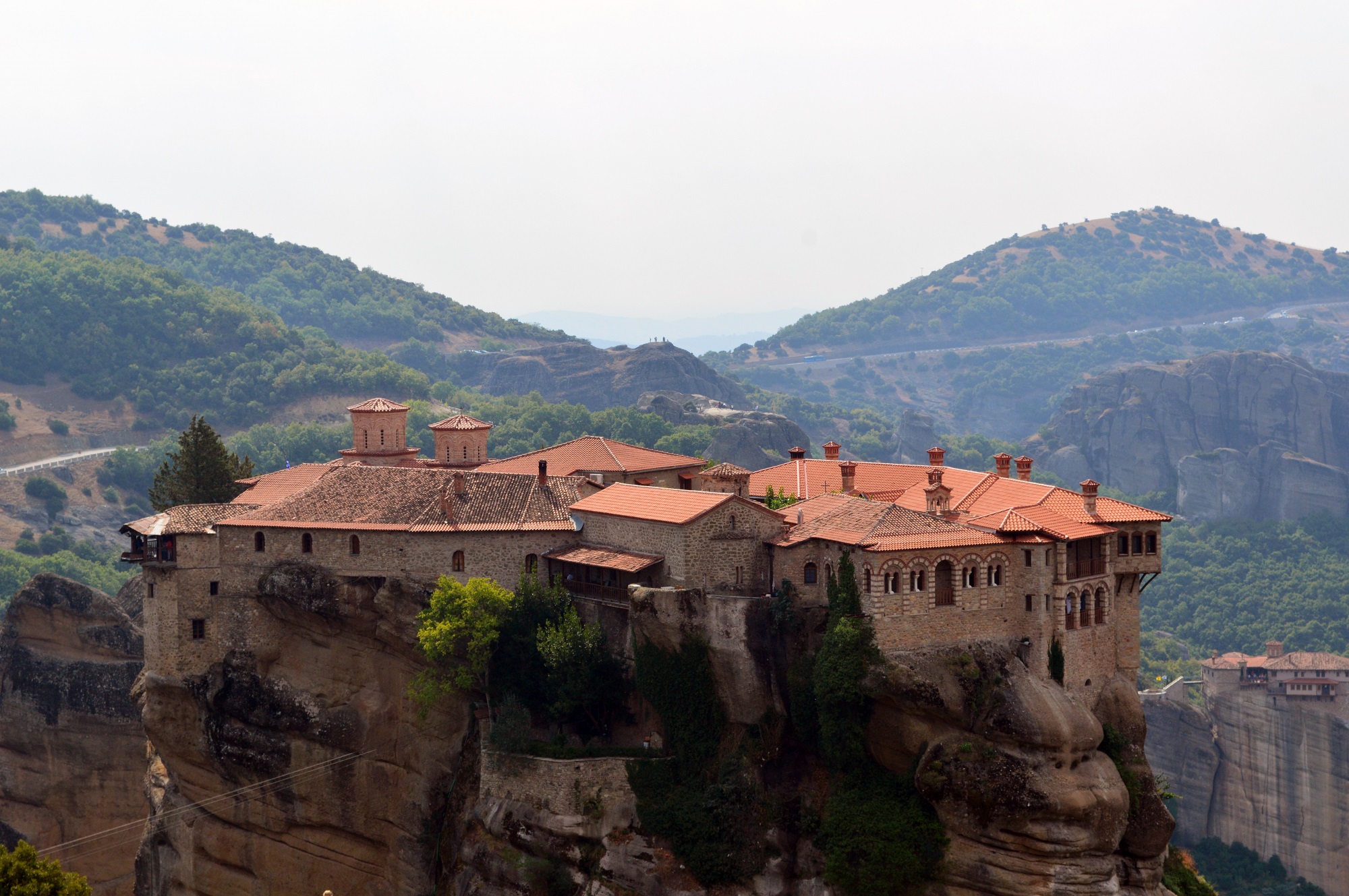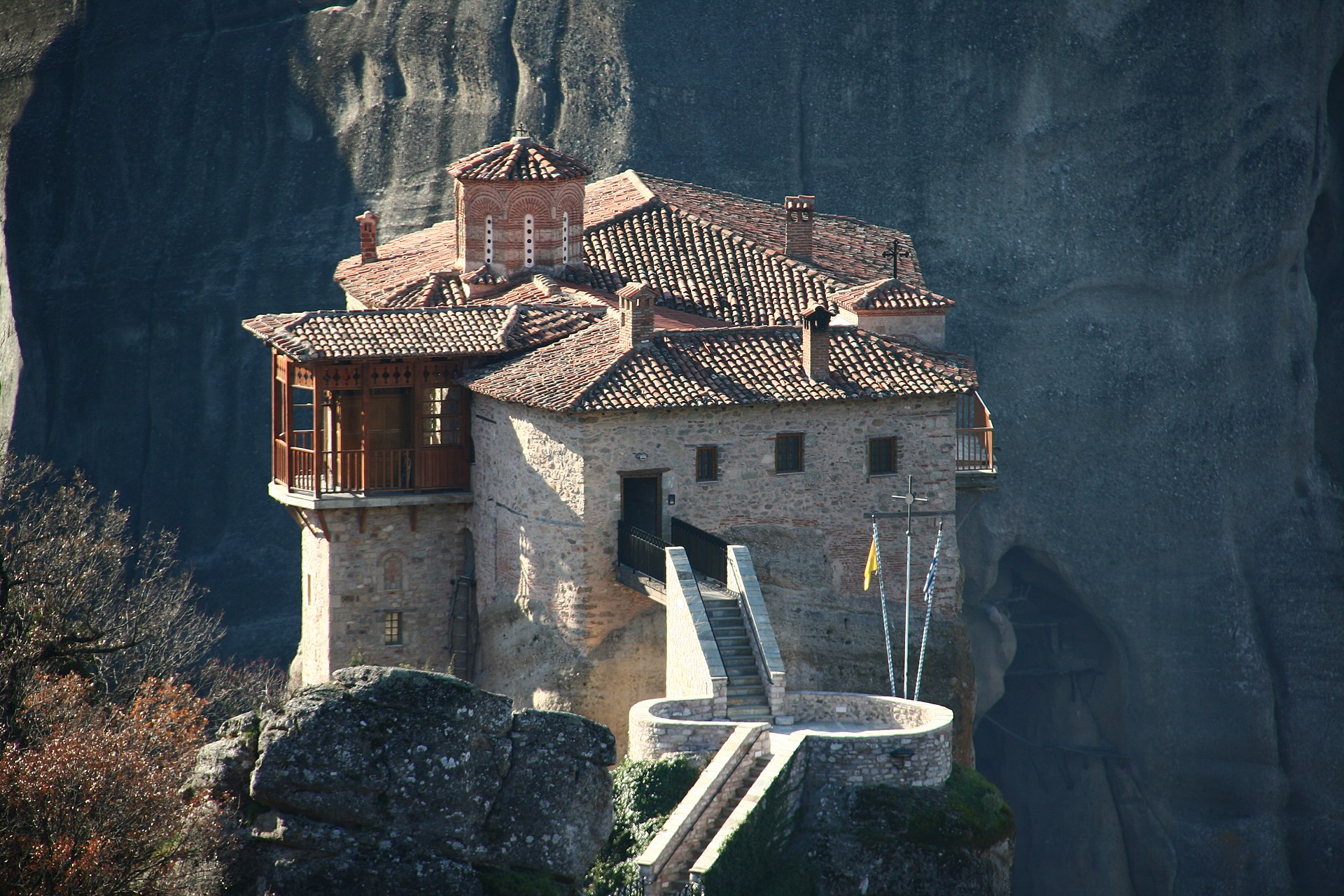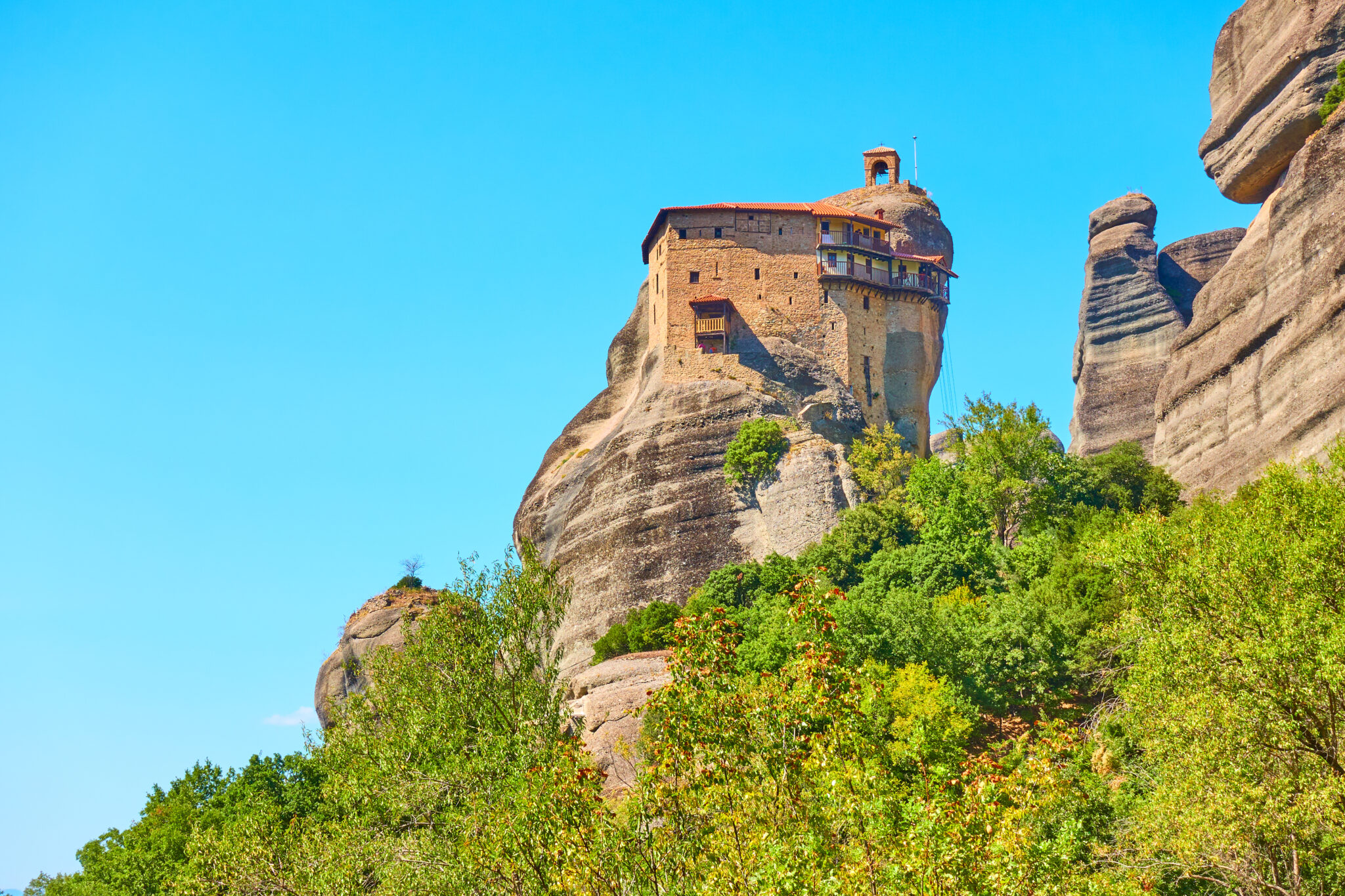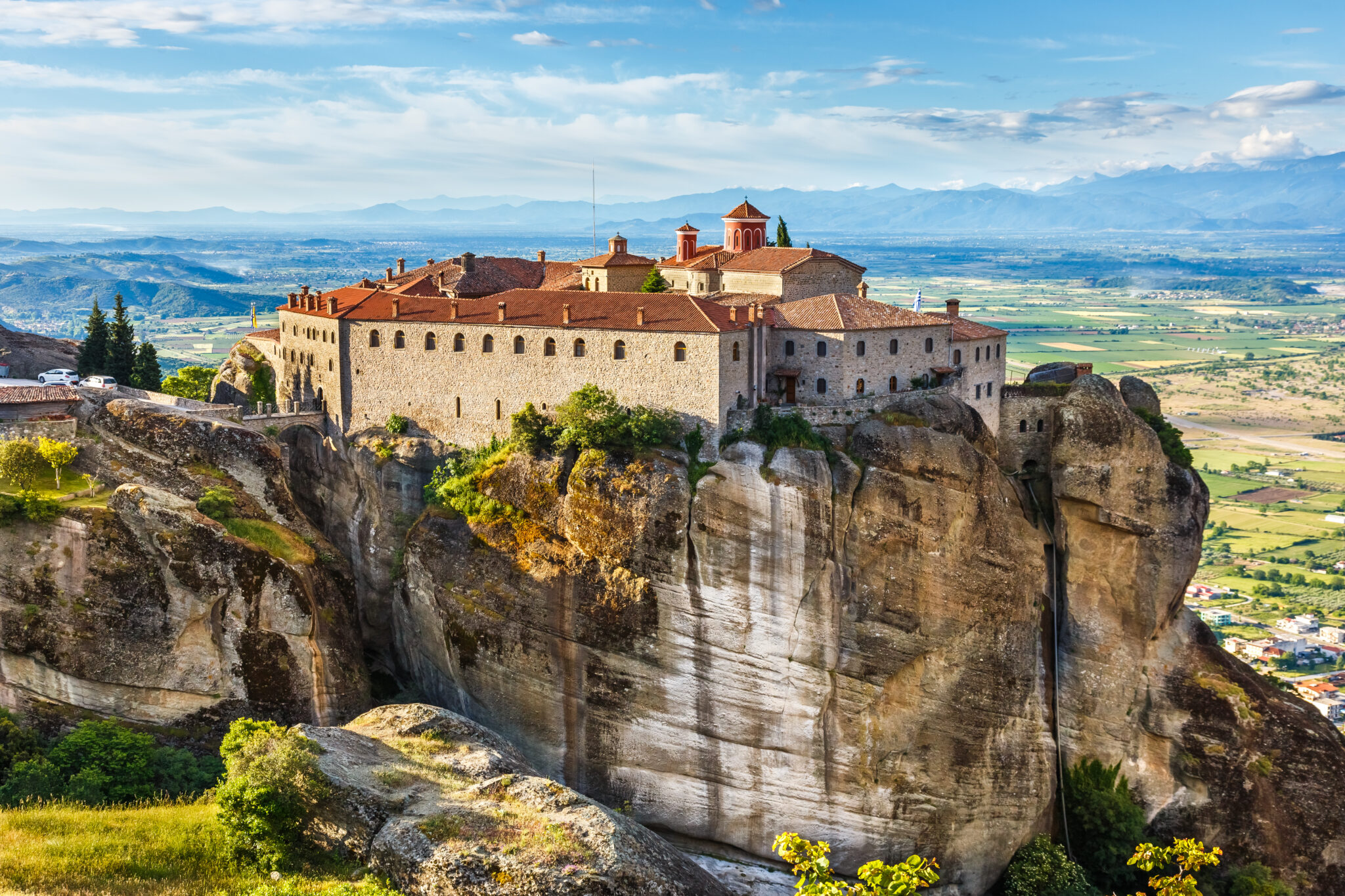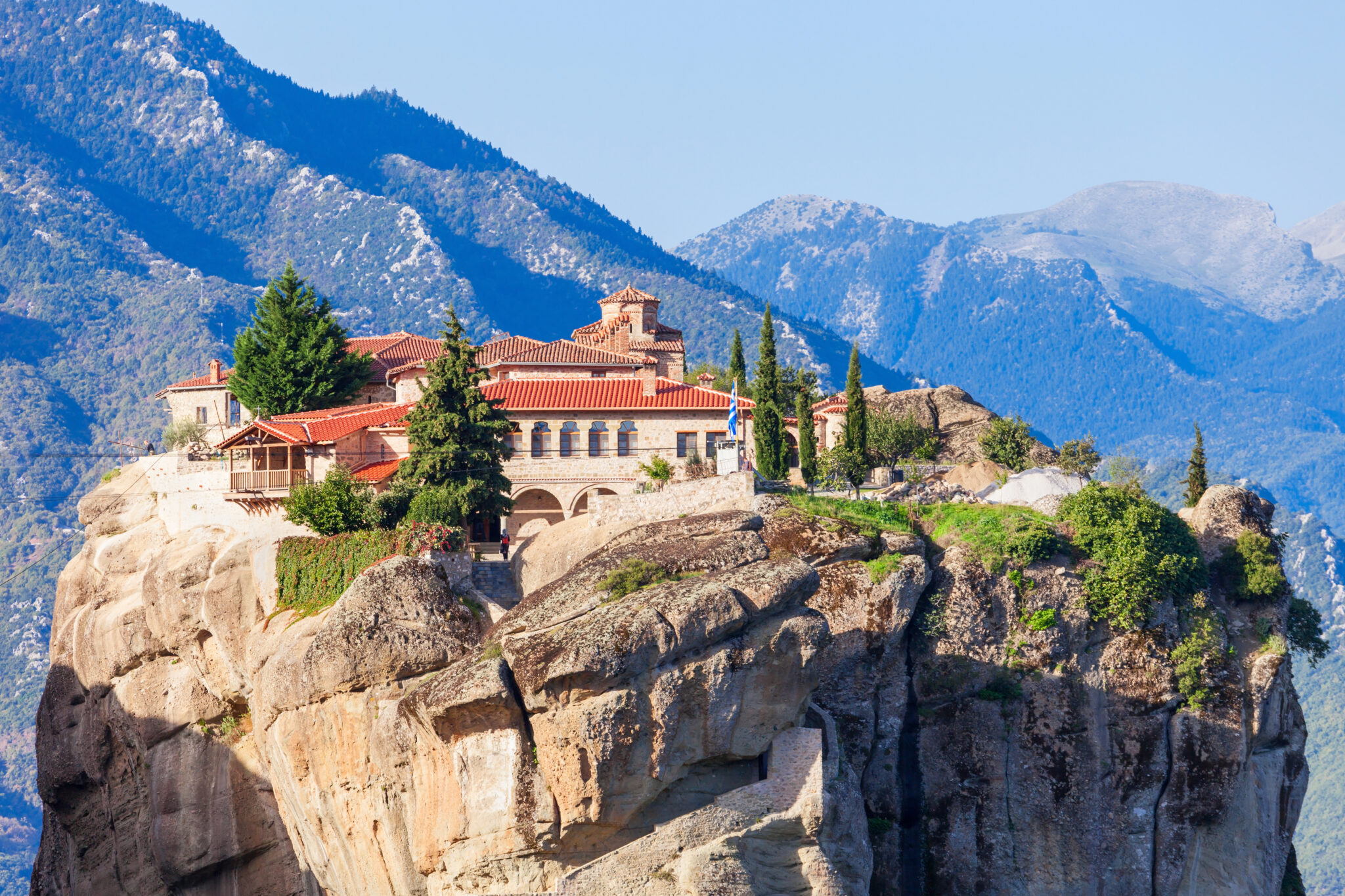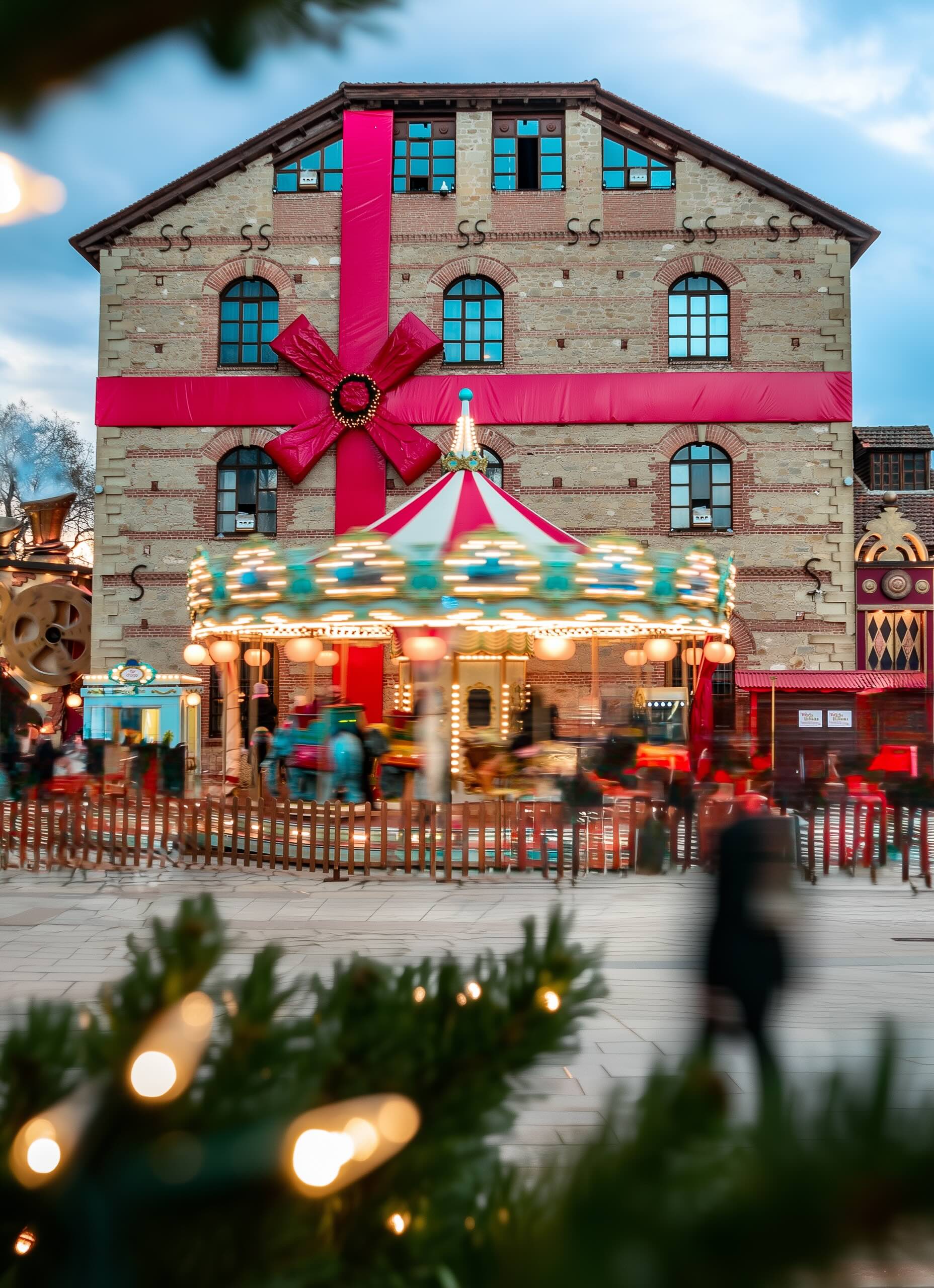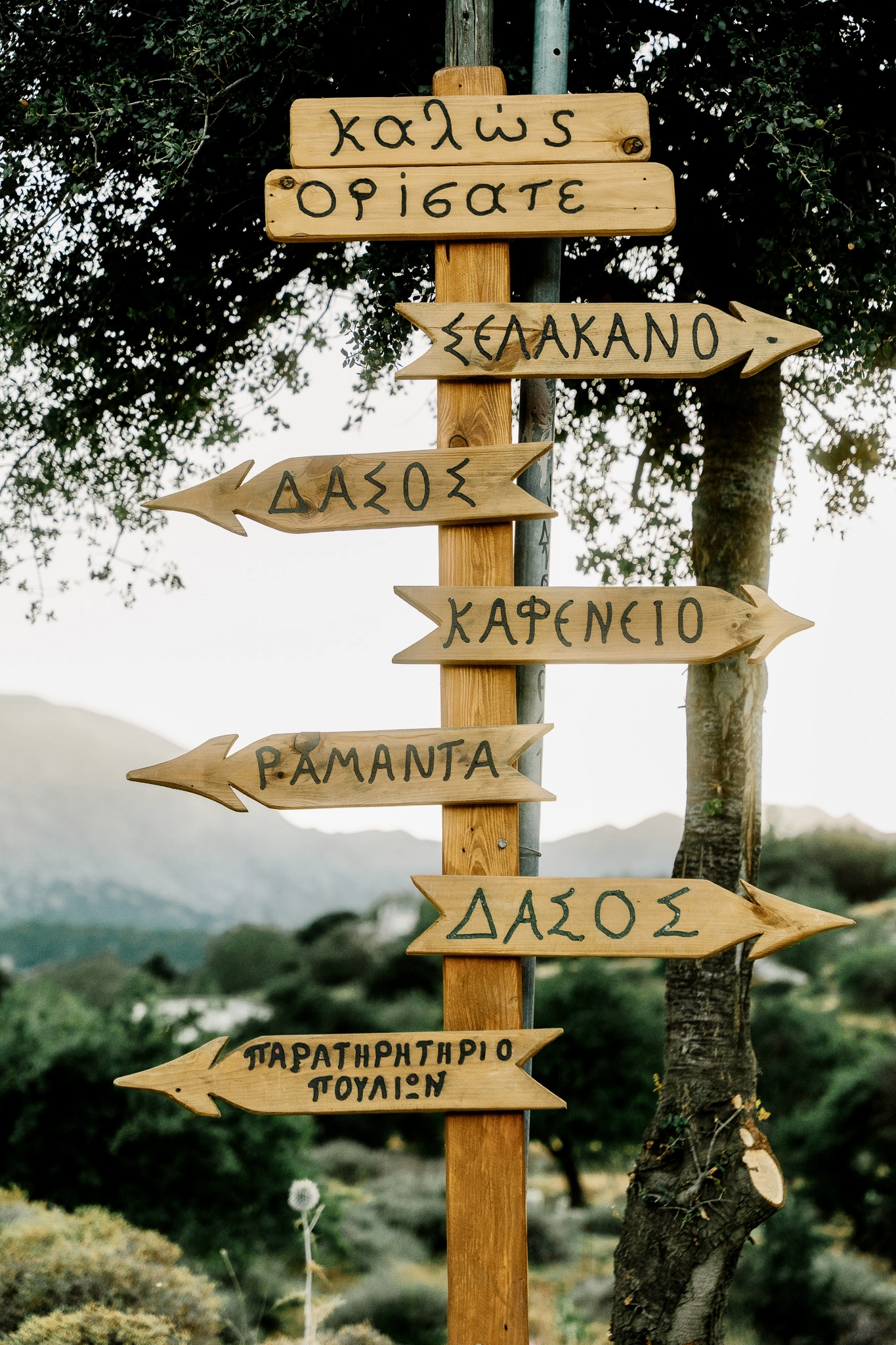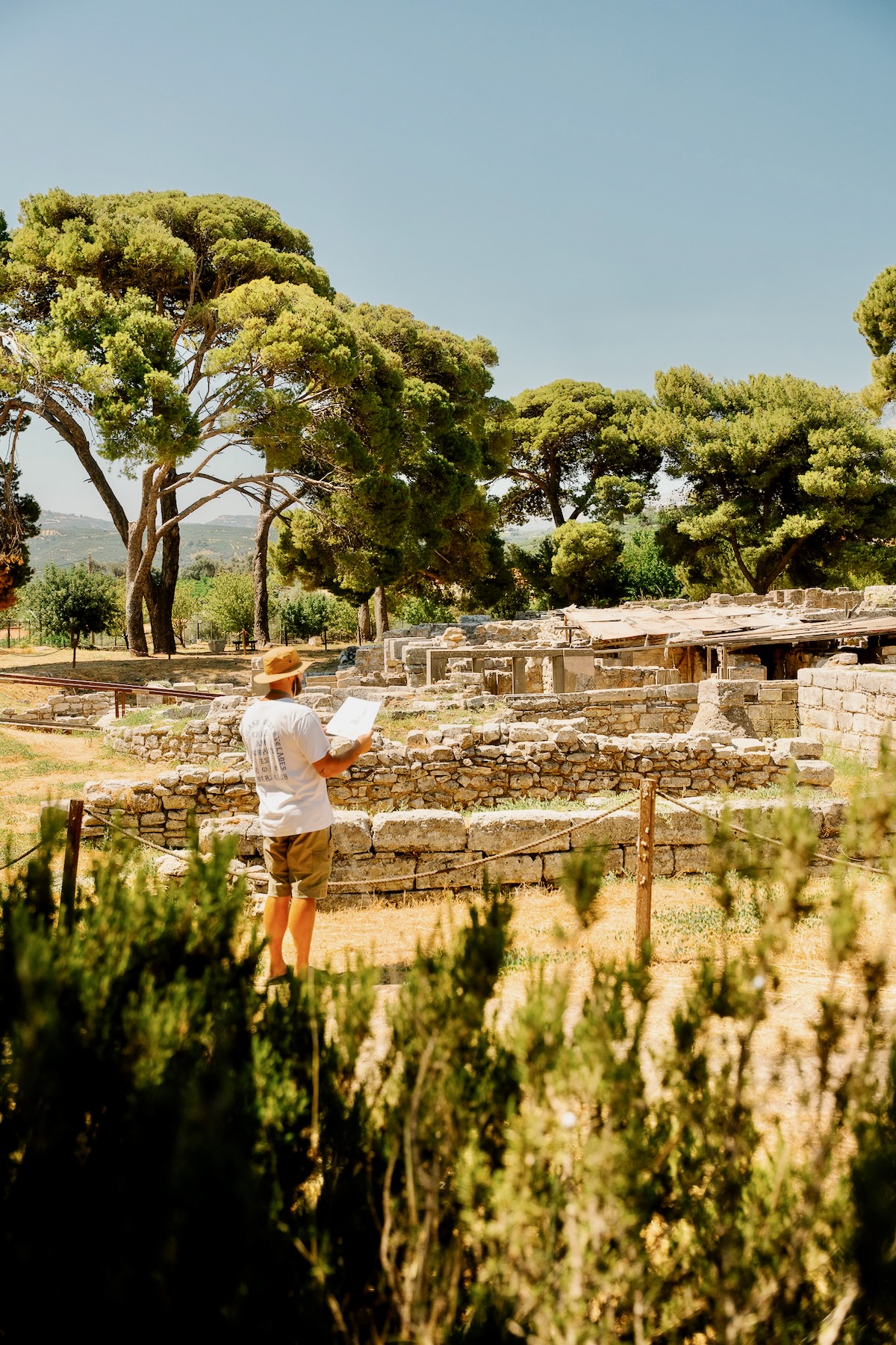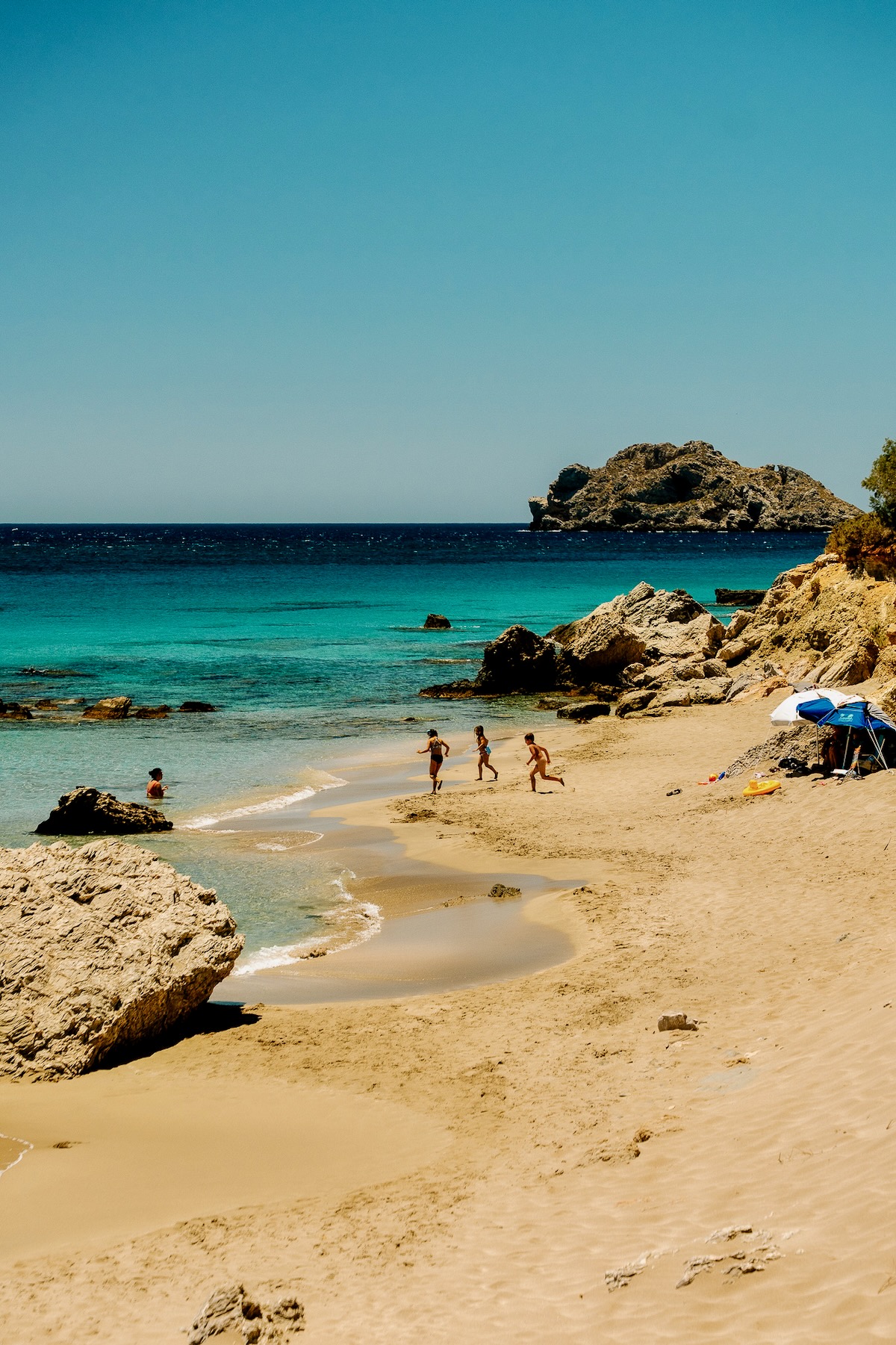In the enigmatic embrace of Thessaly’s rugged landscape, the monasteries of Meteora defy gravity, soaring towards the heavens on colossal stone pillars. Imbued with an ethereal mystique, these ancient sanctuaries whisper tales of hermetic monks, spiritual seekers, and intrepid travelers.
Explore Meteora’s wonders, seeking solace in its solitude and delving into its mysteries. As the golden sun illuminates the monolithic masterpieces, time itself seems to stand still, offering a glimpse of eternity in a world suspended between earth and sky.
Great Meteoron: A Museum of Faith, History, and Art
The Monastery of the Transfiguration of the Savior, also known as Great Meteoron, is more than just a religious refuge; it’s a treasure trove of history and art. Founded by Saint Athanasios around 1340, the original church was dedicated to the Virgin Mary before the second church emerged, dedicated to the Transfiguration of the Savior. Although only a fragment of this second church remains, it was incorporated into the third church built in 1544–1545.
As one explores the hallowed halls, 1483 frescoes adorn the sanctuary, sharing space with the skulls of Saint Athanasios and Ioasaf, encased in silver reliquaries. The 18th-century gilded wooden carved iconostasis and the intricate frescoes enveloping the church walls captivate visitors, while the cantor’s stands, chandeliers, and bishop’s throne reflect an age gone by.
The monastery’s library boasts 640 handwritten codices, Byzantine imperial gold bullae, and 16th-century books. In the ancient trapeza, now transformed into a museum, one can admire priceless icons, vestments, and sacred vessels. Should time be scarce, a visit to this monastery alone will reveal the essence of Meteora’s sacred wonders.
Varlaam Monastery: A Testament to Faith and Resilience
The Varlaam Monastery traces its origins to 1350 when Holy Varlaam, the first hermit to scale the rock, built a modest chapel dedicated to the Three Hierarchs. Following his death, the rock lay abandoned and the chapel crumbled into disrepair. Salvation came in 1517 when two monk brothers, Theophanes and Nektarios Apsaras, arrived from Ioannina and reverently restored the chapel, later founding a monastery that attracted more monks to this secluded abode.
The main church, constructed in 1541-1542, boasts frescoes from 1548 and 1566. Within, visitors can appreciate the gilded wooden-carved iconostasis and the 1688 icon of the Virgin Mary cradling Jesus, painted by Cretan iconographer Emmanuel Tzanes. Due to its challenging access, involving 195 steps carved into the rock, Varlaam Monastery receives fewer visitors, making it an ideal destination for those seeking a more intimate experience.
Roussanou Monastery: Unraveling the Enigma of an Ancient Sanctuary
The origins of the Roussanou Monastery remain shrouded in mystery; its name’s provenance and the identity of the first hermit to ascend the rock are unknown. What we do know is that around 1530, the original church, the Transfiguration of the Savior, lay in ruins. That’s when two brothers from Ioannina, Ioasaf and Maximus, arrived and breathed new life into the church, rebuilding it from the ground up. They also constructed the cells and persuaded fellow monks to join them in this secluded retreat.
The church’s walls are adorned with extraordinary frescoes, painted in 1560, offering a glimpse into the devotion and craftsmanship of the time. Visitors to the Roussanou Monastery can ponder its enigmatic past while appreciating the beauty and serenity of its surroundings.
Agios Nikolaos Anapafsas: Vertical Wonder and Fresco Masterpiece
Perched atop a narrow, lofty rock, the Monastery of Agios Nikolaos Anapafsas is a marvel of vertical ingenuity. With limited space for horizontal expansion, the structure rises skyward, its main church built upon the rock’s unique geometry, and the cells constructed above. This architectural feat results in a small dome without windows, but the true treasure lies within the mesmerizing frescoes.
Painted by renowned Cretan artist Theophanes the Cretan in 1527, these masterpieces showcase the pinnacle of the Cretan School. Visitors can lose themselves in the vivid depictions, particularly the fresco of Adam naming the animals and birds. The origins of the name Anapafsas remain a mystery; however, the first ascetics built a small chapel dedicated to Saint Anthony in the early 14th century. Later, in the early 16th century, a larger church dedicated to Saint Nicholas and auxiliary buildings were added.
Abandoned and closed until 1960, the monastery was restored by the archaeological service, preserving the exquisite frescoes and reviving this vertical wonder for future generations to admire.
Agios Stefanos: Monastic Haven with Effortless Access
The Monastery of Agios Stefanos distinguishes itself as the most accessible of the Meteora monasteries, with no steps to climb and cars reaching its entrance. The first monks to reside here constructed the small church of Agios Stefanos, featuring a beautiful wooden roof, around the mid-15th century. This historic gem still stands on the rock’s southern edge, adorned with mid-16th-century frescoes that have withstood the test of time.
In the early 19th century, the humble church could no longer accommodate the monks’ needs, so a new one was built—without demolishing the old—dedicated to Saint Charalambos. It now resides at the heart of the monastery, surrounded by stone cells where nuns live and other auxiliary buildings that create the appearance of an impregnable fortress. Agios Stefanos offers visitors an effortlessly accessible glimpse into monastic life and architectural splendor.
Agia Triada: The Peaceful Pinnacle of Meteora
Perched precariously atop a slender pinnacle, the Monastery of Agia Triada is Meteora’s most dramatically positioned sanctuary. It might be best known as a James Bond film location, but the truth is that it remains the least visited, making it the most peaceful of all Meteora monasteries. With a tiresome series of 150 steep steps to climb, it’s not for the faint of heart, but it retains the genuine atmosphere of a monastery more than any other.
The present monastery was built between 1458 and 1476, although hermit monks may have lived here as early as the 14th century. Until the 20th century, monks, pilgrims, and supplies reached Agia Triada only by rope-ladders and baskets. In 1925, rock-hewn stairs were added, easing access to the rock. However, it suffered greatly in World War II and the German occupation, during which nearly all its treasures were looted.
Few tour buses venture to Agia Triada, enabling a semblance of monastic life to continue with just a few monks in residence. The courtyard displays old farm implements, an old winch for hauling up baskets, and inspirational biblical quotes. The monastery features attractively half-timbered monastic buildings and a small church built in 1476, with frescoes dating from the 17th and 18th centuries.
Read also:
Road trip to Meteora and the Mountains of Trikala: A Route for all Seasons
Kalabaka: Special museums, tavernas close to Meteora
Meteora: Top hiking routes – trails, monasteries and rocks of an awe-inspiring place in Greece




